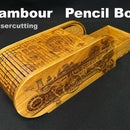Introduction: Wooden Desk Lamp With Levitating Dimmer / Color Changing LED
The idea of this project was to make an unusual or creative wooden desk lamp by using a laser cut which will look not like a laser cut.
The main challenge was making a slim frame and then the software and electronics part.
The lamp stand is made from oak layers, a slim frame from oak (outside), and an alder (inside).
Finish with mineral oil.
For the firmware base, I used the WLED project and enriched it with the Hall-sensor usermod. As a result, I've got a desk lamp with a levitating dimmer, multiple-color animated effects, WiFi control, and a lot of pleasant.
The video is about the process of making
Wooden Desk Lamp with Levitating Dimmer / Color changing LED
#tablelamp #woodworking #lasercutting #diy #wled #led
Supplies
Tools:
- DIY Laser cutter/engraver 520x520mm, 5.5w
- Disk Sander
- Soldering iron
Components:
- Oak sliced veneer 2.5 mm
- Oak sliced veneer 4.5 mm
- Alder sliced veneer 2.5 mm
- Mat plastic (any sort of thin plastic) as a diffuser
- Magnets NdFeB 4x5x2mm, 12pcs
- Fabric braid (Braided cable sleeving)
- Wood glue: Titebond 3
- CA Glue (Gel) + Activator
- Natural mineral oil for wood
- Esp8266 controller
- WS2812b addressable LED strip
- Analog Hall sensor
- USB-C plug
- Some sort of wires
Step 1: Download Sources and Cut With Laser
Everything except the grooves needs to be cut out, I engraved the grooves to a depth of about 1mm.
Attachments
Step 2: Clean the Grooves From Soot
The decorative parts have grooves that will be used to attach the diffuser.
Step 3: Create Alignment Shape
I decided to create a leveling mold using scraps from the laser cutting. This is due to the fact that the frame parts are very thin and will definitely twist after applying glue.
Step 4: Glue the Inner Wood Layer With Decor
I placed the decorative part into the resulting frame for alignment.
Then I quickly applied glue to the next layer and placed it in the frame as well.
Used weight for a tighter fit.
Step 5: The Result After the First Layer Glued
Step 6: Repeat Gluing the Layers to Get a 10mm Height of Frame
I continuously increased the alignment frame height together with gluing the next layer.
Step 7: The Result After the All Layers Glued
After the glue is set the frame is very solid
Step 8: Glue the Stand Base
Quite an easy task, all "O" shapes glued together.
The bottom and top are shown on the photo.
Step 9: Glue the Frame Holder to the Stand
It is advisable to glue the frame holder very precisely. I protected the frame from the glue using masking tape.
Step 10: Polish the Frame and Stand
Step 11: Make a Hole for the USB-C Socket
I used a micro drill and needle files
Step 12: Place the LED Strip in the Frame
Cut the length of the strip by the marked line
Step 13: Cut the Diffuser and Place It in to the Frame
I used some mate plastic, you can use paper, or other materials
Step 14: Solder the Components According to the Diagram
Step 15: Firmware
Here I will not delve too deeply into how to compile/upload the firmware, since this is very well described on the website of the original project WLED
I developed a small usermod for the Hall sensor.
If you want to compile it by yourself sources you can find on my GitHub repository.
Also, I uploaded the already compiled binary to the repository.
Quick guides:
Step 16: Glue the Magnet Holder Rings
Step 17: Put Magnets to the Wooden Holders
The bottom part needs to have one magnet per hole, the top part - one.
Magnets need to be placed with opposite polarity in the top and bottom parts, so they will pull each other.
Fix magnets with CA glue.
Step 18: Polish and Round Holder Parts
Step 19: Glue Hall Sensor in to the Bottom Holder Ring
I bent the sensor legs 90 degrees to place it corresponding to the magnetic field we want to measure.
Step 20: Braided Cable Sleeving, Hall Sensor Wires, Magnet Holder
Place braided cable sleeving to the hall sensor wires and fix it with a magnet holder with glue.
I used braided cable sleeving which I cut from the old headset.
The goals to use it:
- Squeezing and unclenching this tube will fix or release the wires inside it, allowing you to fix the distance of the magnetic ring.
- Decorate wires
Step 21: Fix Cable Sleeving With "H" Part
- Pass the tube through the hole in the "H" part.
- Measure the distance with the tube extended.
- Secure the tube with CA glue.
Very important! Use gel glue and an activator, you only need to glue the tube itself, the wires inside should move freely.
Step 22: Glue the Top Magnet Holder With an Empty Tube
Step 23: Put Hall Sensor Wires and Tube Into the Stand Hole
Step 24: Solder Hall Sensor Wires to the Controller
Solder Hall sensor wires to the controller according to the diagram below.
Put the controller and all wires in to the stand.
Step 25: Secure the Bottom Cover and Frame Holder (H-part) With Screws
Step 26: Fix Top Tube to the Frame
- Put a small holder on the tube
- Measure distance
- FIx holder with CA Glue
- Cut the rest of the tube
- Glue holder to the top part of the frame














